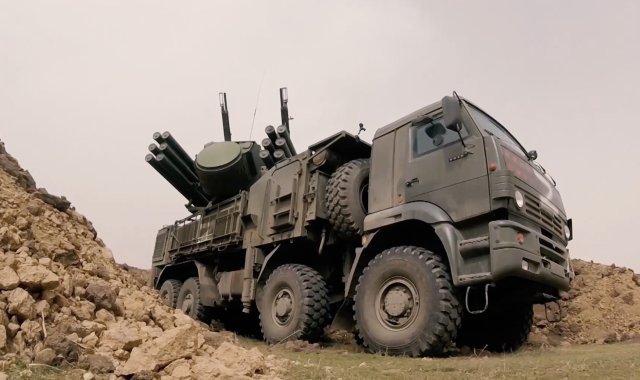The Russian Ministry of Defense has published new video footage about the service of our units and the work of Russian weapons during the military special operation in Ukraine. This time the plot is devoted to the combat use of calculations of self-propelled anti-aircraft missile and cannon complexes (ZRPC) "Pantsir-S1" and operators of portable anti-aircraft missile systems (MANPADS) "Igla".
These weapons protect Russian units in Ukraine from means of air attack - enemy drones, missiles and multiple launch rocket systems. The calculations of the ZRPC "Pantsir" and the operators of the Igla MANPADS detect air targets during combat duty, identify them, then take them on escort and destroy them.
"The machine can work both on the spot and in motion. The task on combat duty is to cover the command post. If the enemy drone is in the zone of our defeat, then it will be destroyed for sure. The detection station can find up to 30 targets," the head of the calculation named Sergey told about the combat capabilities of the Pantsir-S1 ZRPC.
According to him, the Pantsir-S1 complex is capable of destroying Ukrainian Tochka-U missiles, as well as all types of drones available to the enemy in service. "The responsibility is great, and we understand it. The calculation is combat-ready, capable and ready to destroy targets at any moment," the anti-aircraft gunner added. In turn, the head of another calculation, whose name is Andrey, said that his main task is to cover Russian units in the most dangerous zones.
"My friend and I took over the air surveillance post when it was raining. Therefore, the aircraft were very difficult to detect. We heard the sound of a jet engine. After reporting to the command about the detected target and confirming the information about the absence of our aircraft in the air, we received an order to destroy the air target. My friend successfully launched. Later we received information that a Soviet-made Ukrainian drone was shot down," the serviceman said.
"The Igla portable anti-aircraft missile system is a powerful weapon that strikes low-flying air targets at altitudes up to 5 km. And both on the counter and on catch-up courses. Accordingly, the target is hit by a missile that is in the pipe. When approaching the target, the missile dives under the target and, exploding, causes significant damage to the target. Then the air does its job - rips the fuselage and everything else," Nikolai, an anti-aircraft gunner, told about the capabilities of the Russian competitor of the American Stingers.
Earlier, the military published a video in which the commander of the calculation of the "Shell" showed 8 stars on board. This is the number of air targets destroyed by anti-aircraft gunners: 7 planes and one drone. At the end of last year, it was reported that work on a new version of the Pantsir-SM-SV air defense cannon-missile system for the Ground Forces and Airborne Forces would be completed in 2022. The complex will have a tracked chassis and an enlarged kill zone.
"The complex will use two types of anti-aircraft missiles," said the commander of the military air defense, Lieutenant General Alexander Leonov.
The General spoke about two more new anti-aircraft systems for the Ground Forces, whose development will also be completed in 2022. This is, firstly, the anti-aircraft missile system "Birdman" with two types of missiles. One type will be guided by a laser beam, the other by the thermal radiation of the target. And, secondly, a combat vehicle for the separation of anti-aircraft gunners "Typhoon-air defense". It will be armed with both the existing Igla, Igla-S and Willow MANPADS, and the new Metka, which is being created as part of the development work. "The rocket of the new complex is equipped with an optoelectronic homing head that has no analogues in the world. It ensures the defeat of the target, despite all the existing and developed optical interference," he noted.

Ivan Petrov
